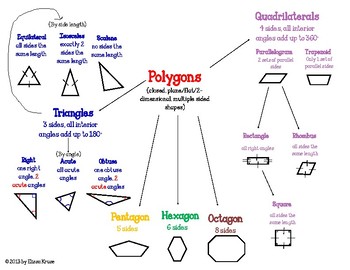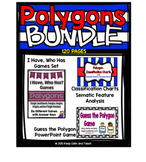Polygon Classification Charts and Semantic Feature Analysis Charts
Keep Calm and Teach
1.6k Followers
Grade Levels
2nd - 9th, Homeschool
Subjects
Resource Type
Standards
CCSS2.G.A.1
CCSS3.G.A.1
CCSS4.G.A.2
CCSS5.G.B.3
CCSS7.G.A.2
Formats Included
- PDF
Pages
10 pages
Keep Calm and Teach
1.6k Followers
What educators are saying
My students were struggling to comprehend the attributes of different polygons and how they relate to one another. This chart helped my students visualize how each of the polygons are related and what they look like. I gave one to every student to use!
Also included in
- This Polygon BUNDLE includes a Polygons Chart and Semantic Feature Analysis Set for students to get familiar with different types of polygons and how they are classified. It also includes 6 I Have Who Has games and 1 PowerPoint Game called Guess the Polygon. It includes several options for differePrice $8.00Original Price $11.00Save $3.00
Description
Polygons Charts and Semantic Feature Analysis Charts teaches about all of the characteristics of polygons and how they are classified and categorized can be very difficult for teachers and confusing for students. These polygons charts show and identify many polygon's characteristics to help students see how they are all related and how they are classified.
The Semantic Feature Analysis Charts are differentiated for different levels of understanding. Some focus on just one type of polygon (ex. triangles only), and some include all of the polygons on the chart. Students must pay close attention to the identifying characteristics.
This resource is great for differentiating activities for your students. With the different versions, you can have students work on the same concepts but use materials that match their needs. These work great for whole class instruction/ introduction of the concepts, small group or guided math, math centers, reteaching, homework, or as a supplement to your math curriculum.
There are two different Polygons Charts included. One is more basic but requires students to fill in information and pictures. The other has all of the defining characteristics and pictures included. It's up to you which one you want to use...maybe both. I use the more detailed one as my master when I am working with students who I'd like to have fill in the information themselves.
Also included is a set of 3 Semantic Feature Analysis Charts- General Polygons, Triangles, and Quadrilaterals. These charts allow your study of polygons to go a step further than just basic recalling and identifying polygons. Each chart has the names of polygons and defining characteristics that describe some or all of the polygons. Students will have to evaluate and analyze the polygons to decide if each characteristic describes each polygon on the chart sometimes, always, or never. These charts often lead to discussion about polygons and student drawing to prove or disprove their thoughts.
We have a Polygons Math Game Set in our store that pairs nicely with this because the content is the same. It is a set of six different I Have, Who Has Games. They focus on all of the polygons seen in this resource and the vocabulary that we use to describe the polygons. The games vary in difficult and scaffold so that you can differentiate for your students and use the games throughout your study of polygons. Click the link below to check it out.
I Have, Who Has Games for Polygons
Do you love a great deal? Here's a BUNDLE of polygon resources, including this resources and 7 games:
Polygons Charts and Games BUNDLERelated Resources: Guess the Polygon Game (PowerPoint) Grades 3 and Up Geometry Math Game Set: Three Dimensional Shapes Candy Math: Fractions, Decimals, Graphing, ... Properties of Multiplication Set Geometry Poster Set Lines Poster Set Transformation PowerPoint (animated) St. Patrick's Day Math: Fractions, Decimals, Percent
Thanks for stopping by!
The Semantic Feature Analysis Charts are differentiated for different levels of understanding. Some focus on just one type of polygon (ex. triangles only), and some include all of the polygons on the chart. Students must pay close attention to the identifying characteristics.
This resource is great for differentiating activities for your students. With the different versions, you can have students work on the same concepts but use materials that match their needs. These work great for whole class instruction/ introduction of the concepts, small group or guided math, math centers, reteaching, homework, or as a supplement to your math curriculum.
There are two different Polygons Charts included. One is more basic but requires students to fill in information and pictures. The other has all of the defining characteristics and pictures included. It's up to you which one you want to use...maybe both. I use the more detailed one as my master when I am working with students who I'd like to have fill in the information themselves.
Also included is a set of 3 Semantic Feature Analysis Charts- General Polygons, Triangles, and Quadrilaterals. These charts allow your study of polygons to go a step further than just basic recalling and identifying polygons. Each chart has the names of polygons and defining characteristics that describe some or all of the polygons. Students will have to evaluate and analyze the polygons to decide if each characteristic describes each polygon on the chart sometimes, always, or never. These charts often lead to discussion about polygons and student drawing to prove or disprove their thoughts.
We have a Polygons Math Game Set in our store that pairs nicely with this because the content is the same. It is a set of six different I Have, Who Has Games. They focus on all of the polygons seen in this resource and the vocabulary that we use to describe the polygons. The games vary in difficult and scaffold so that you can differentiate for your students and use the games throughout your study of polygons. Click the link below to check it out.
I Have, Who Has Games for Polygons
Do you love a great deal? Here's a BUNDLE of polygon resources, including this resources and 7 games:
Polygons Charts and Games BUNDLERelated Resources: Guess the Polygon Game (PowerPoint) Grades 3 and Up Geometry Math Game Set: Three Dimensional Shapes Candy Math: Fractions, Decimals, Graphing, ... Properties of Multiplication Set Geometry Poster Set Lines Poster Set Transformation PowerPoint (animated) St. Patrick's Day Math: Fractions, Decimals, Percent
Thanks for stopping by!
Total Pages
10 pages
Answer Key
Included
Teaching Duration
N/A
Report this resource to TPT
Reported resources will be reviewed by our team. Report this resource to let us know if this resource violates TPT’s content guidelines.
Standards
to see state-specific standards (only available in the US).
CCSS2.G.A.1
Recognize and draw shapes having specified attributes, such as a given number of angles or a given number of equal faces. Identify triangles, quadrilaterals, pentagons, hexagons, and cubes.
CCSS3.G.A.1
Understand that shapes in different categories (e.g., rhombuses, rectangles, and others) may share attributes (e.g., having four sides), and that the shared attributes can define a larger category (e.g., quadrilaterals). Recognize rhombuses, rectangles, and squares as examples of quadrilaterals, and draw examples of quadrilaterals that do not belong to any of these subcategories.
CCSS4.G.A.2
Classify two-dimensional figures based on the presence or absence of parallel or perpendicular lines, or the presence or absence of angles of a specified size. Recognize right triangles as a category, and identify right triangles.
CCSS5.G.B.3
Understand that attributes belonging to a category of two-dimensional figures also belong to all subcategories of that category. For example, all rectangles have four right angles and squares are rectangles, so all squares have four right angles.
CCSS7.G.A.2
Draw (freehand, with ruler and protractor, and with technology) geometric shapes with given conditions. Focus on constructing triangles from three measures of angles or sides, noticing when the conditions determine a unique triangle, more than one triangle, or no triangle.






